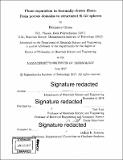| dc.contributor.advisor | Yoel Fink. | en_US |
| dc.contributor.author | Grena, Benjamin (Benjamin Jean-Baptiste) | en_US |
| dc.contributor.other | Massachusetts Institute of Technology. Department of Materials Science and Engineering. | en_US |
| dc.date.accessioned | 2017-09-15T15:29:09Z | |
| dc.date.available | 2017-09-15T15:29:09Z | |
| dc.date.copyright | 2017 | en_US |
| dc.date.issued | 2017 | en_US |
| dc.identifier.uri | http://hdl.handle.net/1721.1/111324 | |
| dc.description | Thesis: Ph. D., Massachusetts Institute of Technology, Department of Materials Science and Engineering, 2017. | en_US |
| dc.description | Cataloged from PDF version of thesis. | en_US |
| dc.description | Includes bibliographical references (pages 149-160). | en_US |
| dc.description.abstract | The preform-to-fiber thermal drawing method is a versatile process that allows the fabrication of polymer or glass-based fibers with complex multimaterial internal structures, which grant them functions ranging from optical transmission to chemical detection. However, while a wide range of materials have been successfully drawn in various phases - such as metals, semiconductors, and ferroelectric polymers - the overall structure of the fiber is typically axially-invariant and the incorporation of heterogeneous materials with isotropic microstructures such as porous domains has remained elusive thus far. In this thesis we investigate the use of in-fiber phase separation as a means to control the microstructure of different components within thermally-drawn fibers. In particular we propose a novel method based on controlled phase separation of a polymer solution that we use to embed isotropically porous polymeric domains inside multimaterial fibers. We achieve this by thermal-drawing a hollow polymer preform filled with a liquid polymer solution in its core. We later apply this method to the fabrication and characterization of scaffolds for neural regeneration. In addition, we show that the same principle can also be used to draw a functional lithium-ion fiber battery; a fiber device capable of electrochemical energy storage. Finally, we demonstrate how to produce structured Si-Ge spheres encapsulated within a silica cladding by inducing capillary breakup of a continuous Si-Ge core fiber in a strong axial thermal gradient. The thermal gradient causes a "kinetic phase separation" of the alloy, leading to structured Janus particles. | en_US |
| dc.description.statementofresponsibility | by Benjamin Grena. | en_US |
| dc.format.extent | 160 pages | en_US |
| dc.language.iso | eng | en_US |
| dc.publisher | Massachusetts Institute of Technology | en_US |
| dc.rights | MIT theses are protected by copyright. They may be viewed, downloaded, or printed from this source but further reproduction or distribution in any format is prohibited without written permission. | en_US |
| dc.rights.uri | http://dspace.mit.edu/handle/1721.1/7582 | en_US |
| dc.subject | Materials Science and Engineering. | en_US |
| dc.title | Phase separation in thermally-drawn fibers: From porous domains to structured Si-Ge spheres | en_US |
| dc.type | Thesis | en_US |
| dc.description.degree | Ph. D. | en_US |
| dc.contributor.department | Massachusetts Institute of Technology. Department of Materials Science and Engineering | |
| dc.identifier.oclc | 1003290053 | en_US |
